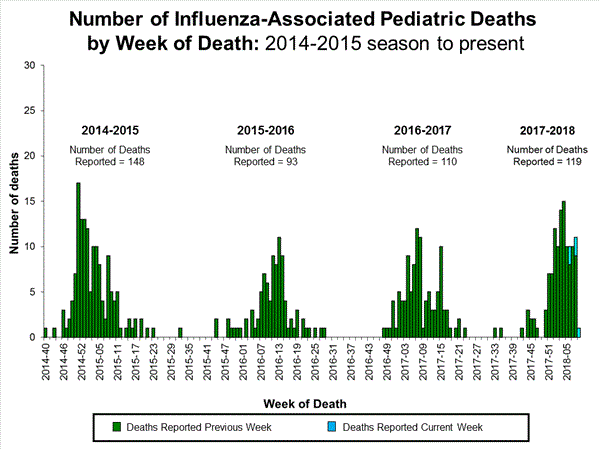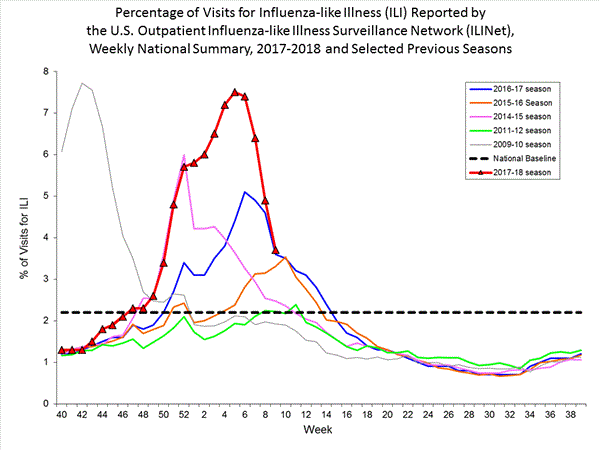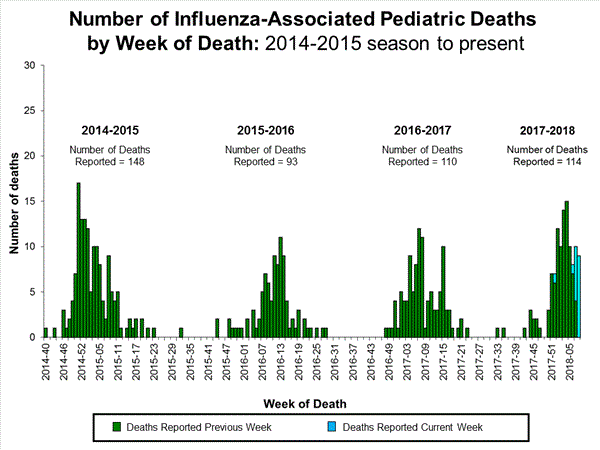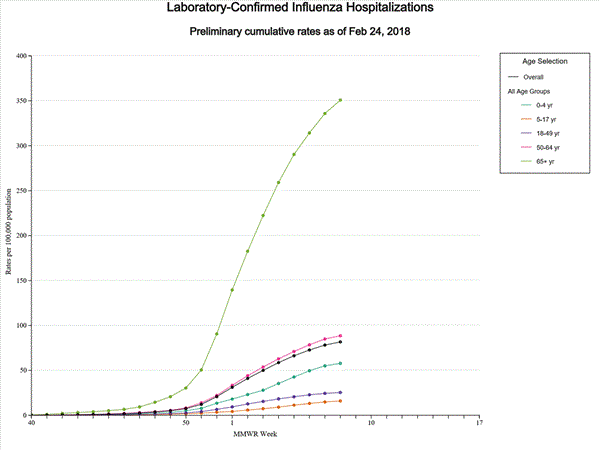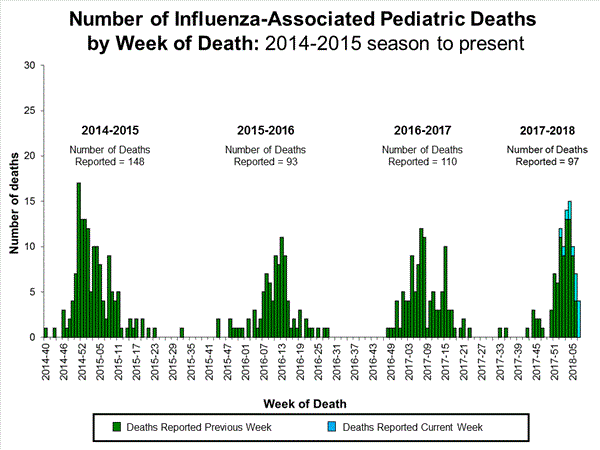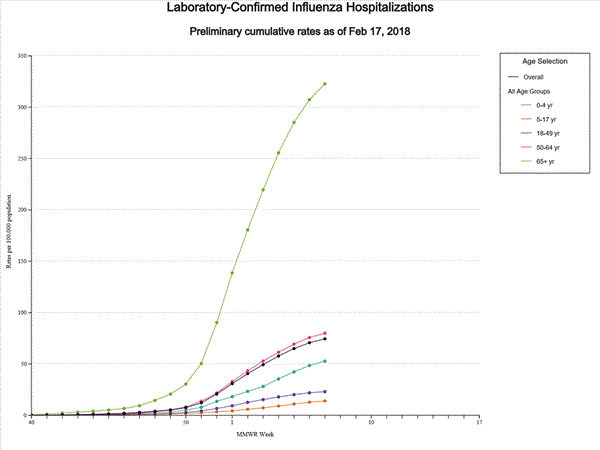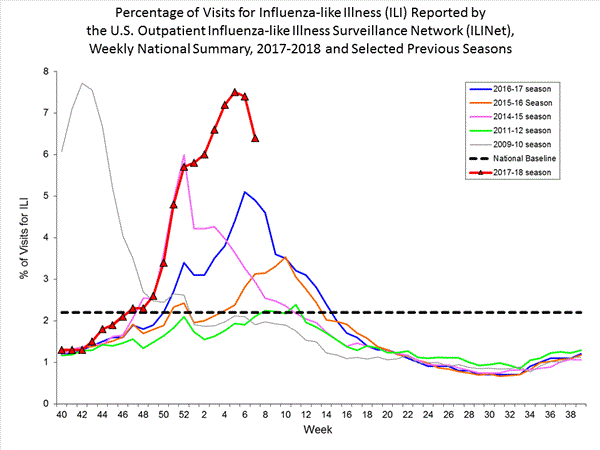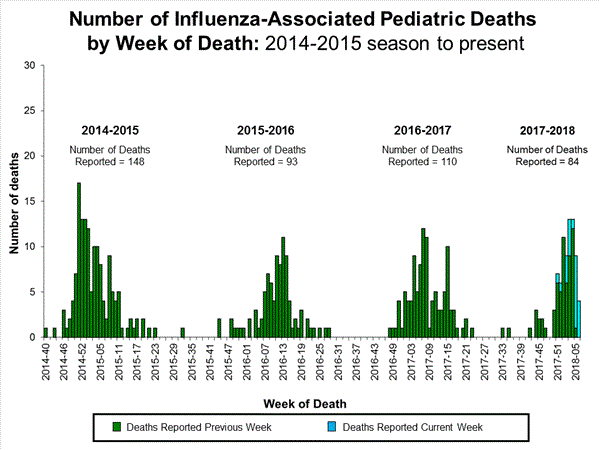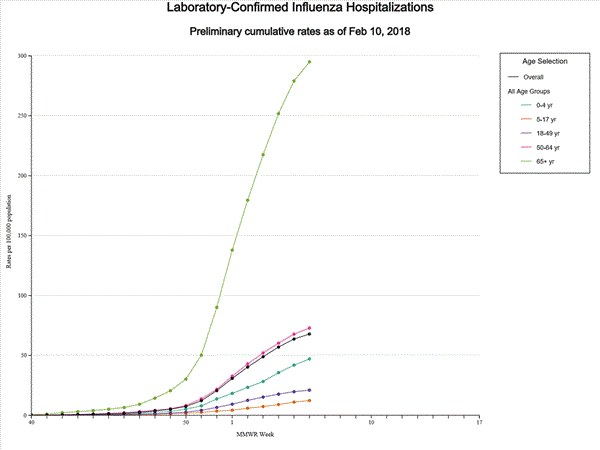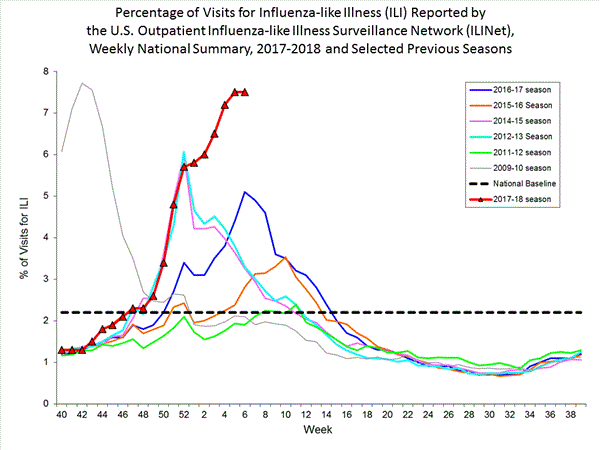Archive for the ‘Influenza’ Category
CDC: influenza-like illness (ILI) activity is markedly down across the country this week, a clear sign that this year’s severe flu season continues to wind down.
Friday, March 9th, 2018Synopsis:
During week 9 (February 25-March 3, 2018), influenza activity decreased in the United States.
- Viral Surveillance: Overall, influenza A(H3) viruses have predominated this season. However, in recent weeks the proportion of influenza A viruses has declined, and during week 9, the numbers of influenza A and influenza B viruses reported were similar. The percentage of respiratory specimens testing positive for influenza in clinical laboratories decreased.
- Pneumonia and Influenza Mortality: The proportion of deaths attributed to pneumonia and influenza (P&I) was above the system-specific epidemic threshold in the National Center for Health Statistics (NCHS) Mortality Surveillance System.
- Influenza-associated Pediatric Deaths: Five influenza-associated pediatric deaths were reported.
- Influenza-associated Hospitalizations: A cumulative rate of 86.3 laboratory-confirmed influenza-associated hospitalizations per 100,000 population was reported.
- Outpatient Illness Surveillance:The proportion of outpatient visits for influenza-like illness (ILI) was 3.7%, which is above the national baseline of 2.2%. All 10 regions reported ILI at or above region-specific baseline levels. New York City and 21 states experienced high ILI activity; 15 states experienced moderate ILI activity; the District of Columbia, Puerto Rico, and five states experienced low ILI activity; and nine states experienced minimal ILI activity.
- Geographic Spread of Influenza:The geographic spread of influenza in Puerto Rico and 34 states was reported as widespread; Guam and 12 states reported regional activity; the District of Columbia and four states reported local activity; and the U.S. Virgin Islands reported no activity.
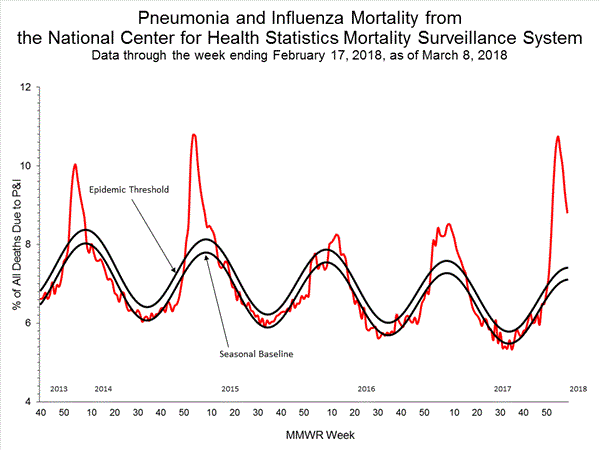
CDC: Week 8 (February 18-24, 2018), influenza activity decreased in the United States.
Saturday, March 3rd, 2018Synopsis:
During week 8 (February 18-24, 2018), influenza activity decreased in the United States.
- Viral Surveillance: While influenza A(H3) viruses continue to be predominant this season, during week 8 the overall proportion of influenza A viruses is declining and the proportion of influenza B viruses is increasing. The percentage of respiratory specimens testing positive for influenza in clinical laboratories decreased.
- Pneumonia and Influenza Mortality: The proportion of deaths attributed to pneumonia and influenza (P&I) was above the system-specific epidemic threshold in the National Center for Health Statistics (NCHS) Mortality Surveillance System.
- Influenza-associated Pediatric Deaths: Seventeen influenza-associated pediatric deaths were reported.
- Influenza-associated Hospitalizations: A cumulative rate of 81.7 laboratory-confirmed influenza-associated hospitalizations per 100,000 population was reported.
- Outpatient Illness Surveillance: The proportion of outpatient visits for influenza-like illness (ILI) was 5.0%, which is above the national baseline of 2.2%. All 10 regions reported ILI at or above region-specific baseline levels. New York City, the District of Columbia, and 32 states experienced high ILI activity; Puerto Rico and nine states experienced moderate ILI activity; six states experienced low ILI activity; and three states experienced minimal ILI activity.
- Geographic Spread of Influenza: The geographic spread of influenza in Puerto Rico and 45 states was reported as widespread; Guam and two states reported regional activity; the District of Columbia and three states reported local activity; and the U.S. Virgin Islands reported no activity.
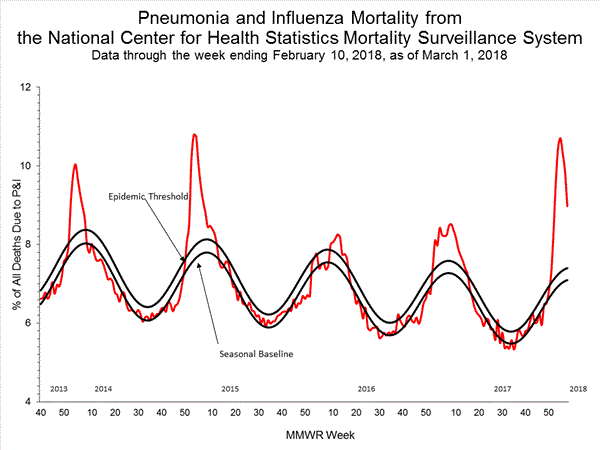
NIAID (National Institute of Allergy and Infectious Diseases): A strategic plan for developing a universal influenza vaccine
Thursday, March 1st, 2018“…..To develop a universal influenza vaccine, NIAID will focus resources on three key areas of influenza research: improving the understanding of the transmission, natural history and pathogenesis of influenza infection; precisely characterizing how protective influenza immunity occurs and how to tailor vaccination responses to achieve it; and supporting the rational design of universal influenza vaccines, including designing new immunogens and adjuvants to boost immunity and extend the duration of protection.…..”
Emily J Erbelding, Diane Post, Erik Stemmy, Paul C Roberts, Alison Deckhut Augustine, Stacy Ferguson, Catharine I Paules, Barney S Graham, Anthony S Fauci; A Universal Influenza Vaccine: The Strategic Plan for the National Institute of Allergy and Infectious Diseases, The Journal of Infectious Diseases, , jiy103, https://doi.org/10.1093/infdis/jiy103
Use of Influenza Risk Assessment Tool (IRAT) for Prepandemic Preparedness
Sunday, February 25th, 2018“…..Although only 3 hemagglutinin (HA) subtypes of influenza (H1, H2, and H3) are known to have caused human pandemics, the emergence and spread of influenza A(H5N1) and, more recently, influenza A(H7N9), with associated high death rates in humans, are of great concern. If these or other influenza A viruses not currently circulating among humans develop the capability to transmit efficiently among humans, they pose a risk for causing a pandemic that could be associated with high rates of illness and death…….
The IRAT uses a common decision analysis approach that incorporates input from multiple elements or attributes, applies a weighting scheme, and generates a score to compare various options or decisions (11). In regard to the evaluation of animal-origin influenza viruses for their potential human pandemic risk, 2 specific questions were developed related to the potential risk for emergence and consequent potential impact: 1) What is the risk that a virus not currently circulating in humans has the potential for sustained human-to-human transmission? (emergence question); and 2) If a virus were to achieve sustained human-to-human transmission, what is the risk that a virus not currently circulating among humans has the potential for substantial impact on public health? (impact question).
In developing the IRAT, a working group of international influenza experts in influenza virology, animal health, human health, and epidemiology identified 10 risk elements and definitions. These elements were described previously (10); in brief, they include virus properties (genomic variation, receptor-binding properties, transmissibility in animal models, and antiviral treatment susceptibility) and host properties (population immunity, disease severity, and antigenic relationship to vaccines). The final 3 elements are based on the epidemiologic and ecologic evidence: infection in humans, infections in animals, and global distribution in animals. These elements are used to answer the 2 risk questions to evaluate an influenza virus of interest. The 10 elements are ranked and weighted on the basis of their perceived importance to answering the specific risk questions and an aggregate risk score is generated……….“
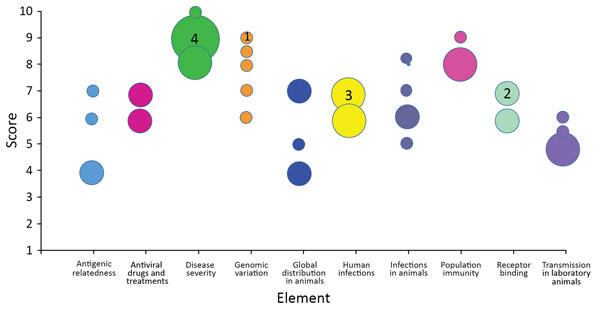
Individual subject-matter expert point scores by element for the May 2017 scoring of influenza A(H7N9) virus, A/Hong Kong/125/2017, based on risk element definitions. Circles indicate individual point scores; circle sizes (examples indicated by a number inside) correspond to the frequency of each point score.
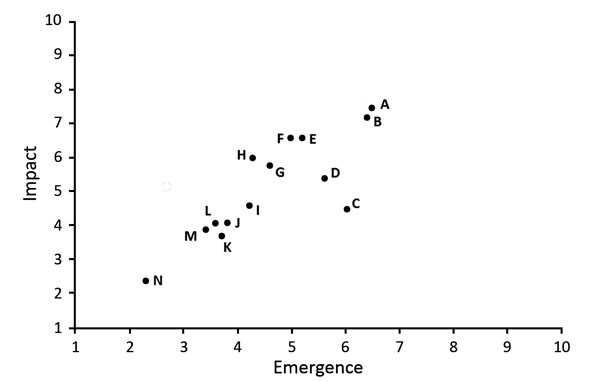
Comparison of average emergence and impact scores for 14 animal-origin influenza viruses using the Influenza Risk Assessment Tool. Circle represents each virus: A, H7N9 A/Hong Kong/125/2017; B, H7N9 A/Shanghai/02/2013; C, H3N2 variant A/Indiana/08/2011; D, H9N2 G1 lineage A/Bangladesh/0994/2011; E, H5N1 clade 1 A/Vietnam/1203/2004; F, H5N6 A/Yunnan/14564/2015-like; G, H7N7 A/Netherlands/2019/2003; H, H10N8 A/Jiangxi-Donghu/346/2013; I, H5N8 A/gyrfalcon/Washington/41088/2014; J, H5N2 A/Northern pintail/Washington/40964/2014; K, H3N2 A/canine/Illinois/12191/2015; L, H5N1 A/American green-winged teal/Washington/1957050/2014; M, H7N8 A/turkey/Indiana/1573-2/2016; N, H1N1 A/duck/New York/1996. Additional information about virus scores and individual viruses is available at https://www.cdc.gov/flu/pandemic-resources/monitoring/irat-virus-summaries.htm.
| Burke SA, Trock SC. Use of Influenza Risk Assessment Tool for Prepandemic Preparedness. Emerg Infect Dis. 2018;24(3):471-477. https://dx.doi.org/10.3201/eid2403.171852 |
Japan: a potentially groundbreaking new drug (Xofluza) that can kill the flu virus in just one day has won regulatory approval
Saturday, February 24th, 2018“…….Xofluza….could soon prove to be a significant competitor to Swiss drug giant Roche’s Tamiflu…. But it could also take until at least 2019 for Xofluza to reach the U.S. market. Xofluza ….requires far fewer doses—just a single pill, in fact, compared with the five-day, two-doses-per-day regimen required by Tamiflu…..Xofluza was able to kill off the flu virus in 24 hours….”
2017-2018 Influenza Season Week 7 ending February 17, 2018
Saturday, February 24th, 2018Synopsis:
During week 7 (February 11-17, 2018), influenza activity remained elevated in the United States.
- Viral Surveillance: The most frequently identified influenza virus subtype reported by public health laboratories during week 7 was influenza A(H3). The percentage of respiratory specimens testing positive for influenza in clinical laboratories remained elevated.
- Pneumonia and Influenza Mortality: The proportion of deaths attributed to pneumonia and influenza (P&I) was above the system-specific epidemic threshold in the National Center for Health Statistics (NCHS) Mortality Surveillance System.
- Influenza-associated Pediatric Deaths: Thirteen influenza-associated pediatric deaths were reported.
- Influenza-associated Hospitalizations: A cumulative rate of 74.5 laboratory-confirmed influenza-associated hospitalizations per 100,000 population was reported.
- Outpatient Illness Surveillance:The proportion of outpatient visits for influenza-like illness (ILI) was 6.4%, which is above the national baseline of 2.2%. All 10 regions reported ILI at or above region-specific baseline levels. New York City, the District of Columbia, Puerto Rico and 39 states experienced high ILI activity; five states experienced moderate ILI activity; three states experienced low ILI activity; and three states experienced minimal ILI activity.
- Geographic Spread of Influenza:The geographic spread of influenza in Puerto Rico and 48 states was reported as widespread; the District of Columbia, Guam and two states reported local activity; and the U.S. Virgin Islands reported no activity.
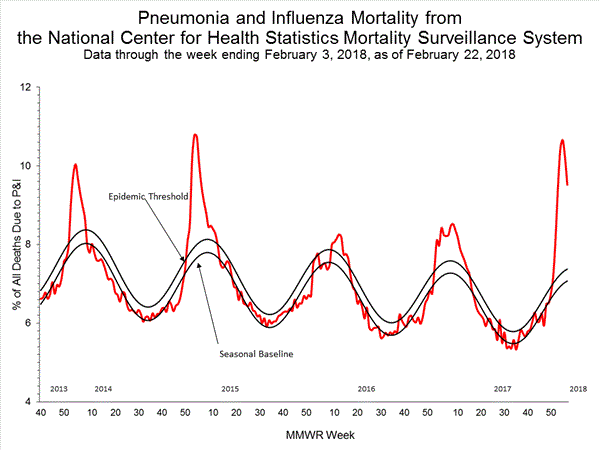
WHO: Recommended composition of influenza virus vaccines for use in the 2018-2019 northern hemisphere influenza season
Friday, February 23rd, 2018Recommended composition of influenza virus vaccines for use in the 2018-2019 northern hemisphere influenza season
22 February 2018
It is recommended that quadrivalent vaccines for use in the 2018-2019 northern hemisphere influenza season contain the following:
- an A/Michigan/45/2015 (H1N1)pdm09-like virus;
- an A/Singapore/INFIMH-16-0019/2016 (H3N2)-like virus;
- a B/Colorado/06/2017-like virus (B/Victoria/2/87 lineage); and
- a B/Phuket/3073/2013-like virus (B/Yamagata/16/88 lineage).
It is recommended that the influenza B virus component of trivalent vaccines for use in the 2018-2019 northern hemisphere influenza season be a B/Colorado/06/2017-like virus of the B/Victoria/2/87-lineage.
For more information
Influenza update – 19 February 2018
Wednesday, February 21st, 2018
Summary
Influenza activity remained high in the temperate zone of the northern hemisphere while in the temperate zone of the southern hemisphere activity was at inter-seasonal levels. Worldwide, influenza A accounted still for the majority of influenza detections but influenza B (mostly B-Yamagata lineage) increased in recent weeks.
Up to now, the majority of countries which are in the influenza season, reported influenza- like illness reaching moderate levels in comparison with previous years, with few reaching levels exceeding those of previous years. Some countries however have reported levels of hospitalization and ICU admissions reaching or exceeding peak levels of previous influenza seasons. WHO recommends countries with current influenza activity or entering their season to adopt necessary measures for ensuring appropriate case management, compliance with infection control measures and seasonal influenza vaccination for high risk groups(see also the fact sheet given below).
- Overall, influenza virus activity remained high in the region. In Canada, influenza activity remain elevated while influenza-like illness (ILI) activity continued to increase and was above the 5-year average for this time of the year. Influenza B detections increased in recent weeks reaching equal proportion as influenza A detections. In the United States of America (USA), influenza activity remained high, with influenza A (H3N2) viruses most frequently detected followed by influenza B viruses. Hospitalization cumulative rate for influenza were reported at high levels, and above levels observed during the same period over the previous seven seasons. In both Canada and the USA, adults aged 65 years and older accounted for the majority of influenza cases and influenza-related hospitalizations. In Mexico, influenza activity decreased slightly, with influenza A(H3N2) virus predominantly detected.
- In Europe, influenza activity remained high in most countries. All seasonal influenza subtypes co-circulated across the region, but influenza B virus predominated in most countries. ILI and influenza detections increased further in most countries in Eastern and Northern Europe, and appeared to have peaked in few countries in Southwestern Europe. Influenza B detections increased in Denmark, Estonia, Norway, and Sweden. Influenza illness indicators appeared to decrease in Ireland and the United Kingdom, but influenza-related hospitalizations remain high in England.
- In Northern Africa, influenza detections remained high in Algeria, Egypt and Morocco, and continued to decrease in Tunisia. Influenza A(H1N1)pdm09 virus predominated in Algeria and Tunisia, and detections of influenza A(H1N1)pdm09 and influenza B were reported in Egypt and Morocco.
- In Western Asia, influenza activity continued to be reported across the region. In some countries of the Arabian Peninsula, influenza activity appeared to have peaked, while increased influenza A(H1N1)pdm09 detections were reported in Iraq. In Israel, influenza activity remained high with influenza B viruses predominating. Detections of influenza B-Yamagata lineage and influenza A(H1N1)pdm09 were reported in Armenia.
- In Central Asia, influenza A and B detections increased across the region in recent weeks.
- In East Asia, influenza activity remained high across the region. ILI activity appeared to decrease in Northern and Southern China but influenza detections remained elevated, with influenza B-Yamagata lineage and influenza A(H1N1)pdm09 viruses predominating. ILI consultation rate remained high in Hong Kong SAR, China, with influenza B most frequently detected. Decreased detections of influenza A(H1N1)pdm09 were reported in the Democratic People’s Republic of Korea. In Mongolia, respiratory illness indicators and influenza detections appeared to decrease whit influenza B-Yamagata lineage virus predominately detected in recent weeks. In the Republic of Korea, ILI activity decreased although influenza A(H3N2) and B virus detections remained high.
- In Southern Asia, influenza activity remained low in general. Detection of influenza A(H1N1)pdm09 and influenza A(H3N2) viruses continued to increase in Pakistan, while activity decreased in the Islamic Republic of Iran.
- In South East Asia, low levels of influenza activity were reported in most countries. Increased detections of influenza A(H1N1)pdm09 and influenza B-Yamagata lineage viruses were reported in Singapore.
- In Western Africa, little to no influenza activity was reported across the region. In Middle Africa, there were no updates available for this reporting period. In Eastern Africa, increased influenza A(H1N1)pdm09 detections were reported in Madagascar.
- In the Caribbean and Central American countries, respiratory illness indicators and influenza activity remained low in general. Influenza activity increased in Puerto Rico, with influenza A(H3N2) and B viruses co-circulating. Increased detections of influenza B virus were reported in Suriname. Influenza activity decreased in Jamaica.
- In the tropical countries of South America, influenza activities and respiratory illness indicators were generally low with a few exceptions. Influenza A(H3N2) detections slightly increased in Colombia. Influenza activity remained elevated in Ecuador, with influenza A(H1N1)pdm09 virus predominating.
- In the temperate zone of the Southern Hemisphere, influenza activity remained overall at inter-seasonal levels.
- National Influenza Centres (NICs) and other national influenza laboratories from 104 countries, areas or territories reported data to FluNet for the time period from 22 January 2018 to 04 February 2018 (data as of 2018-02-16 04:33:50 UTC).The WHO GISRS laboratories tested more than 302596 specimens during that time period. 98068 were positive for influenza viruses, of which 54142 (55.2%) were typed as influenza A and 43926 (44.8%) as influenza B. Of the sub-typed influenza A viruses, 10290 (58%) were influenza A(H1N1)pdm09 and 7441 (42%) were influenza A(H3N2). Of the characterized B viruses, 7553 (92.5%) belonged to the B-Yamagata lineage and 615 (7.5%) to the B-Victoria lineage.
2017-2018 Influenza Season Week 6 ending February 10, 2018: influenza activity remained elevated.
Saturday, February 17th, 2018Synopsis:
During week 6 (February 4-10, 2018), influenza activity remained elevated in the United States.
- Viral Surveillance: The most frequently identified influenza virus subtype reported by public health laboratories during week 6 was influenza A(H3). The percentage of respiratory specimens testing positive for influenza in clinical laboratories remained elevated.
- Pneumonia and Influenza Mortality: The proportion of deaths attributed to pneumonia and influenza (P&I) was above the system-specific epidemic threshold in the National Center for Health Statistics (NCHS) Mortality Surveillance System.
- Influenza-associated Pediatric Deaths: Twenty-two influenza-associated pediatric deaths were reported.
- Influenza-associated Hospitalizations: A cumulative rate of 67.9 laboratory-confirmed influenza-associated hospitalizations per 100,000 population was reported.
- Outpatient Illness Surveillance:The proportion of outpatient visits for influenza-like illness (ILI) was 7.5%, which is above the national baseline of 2.2%. All 10 regions reported ILI at or above region-specific baseline levels. New York City, the District of Columbia, Puerto Rico and 43 states experienced high ILI activity; two states experienced moderate ILI activity; three states experienced low ILI activity; and two states experienced minimal ILI activity.
- Geographic Spread of Influenza:The geographic spread of influenza in Puerto Rico and 48 states was reported as widespread; one state reported regional activity; the District of Columbia, Guam and one state reported local activity; and the U.S. Virgin Islands reported no activity.
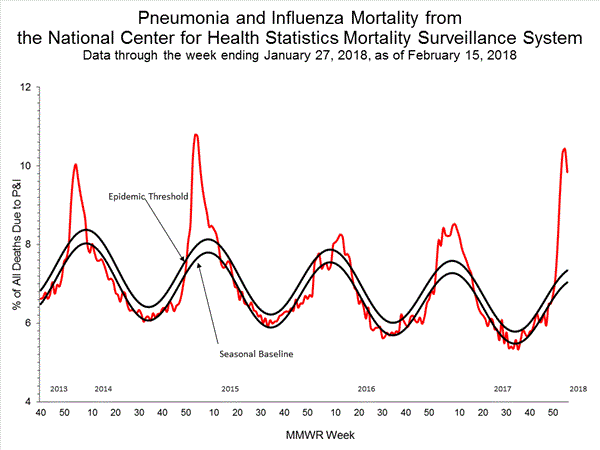
Far-UVC efficiently inactivates airborne aerosolized viruses, with a very low dose of 2 mJ/cm2 of 222-nm light inactivating >95% of aerosolized H1N1 influenza virus.
Monday, February 12th, 2018Far-UVC light: A new tool to control the spread of airborne-mediated microbial diseases
- Scientific Reports; volume 8, Article number: 2752 (2018)
- doi:10.1038/s41598-018-21058-w
“Airborne-mediated microbial diseases such as influenza and tuberculosis represent major public health challenges. A direct approach to prevent airborne transmission is inactivation of airborne pathogens, and the airborne antimicrobial potential of UVC ultraviolet light has long been established; however, its widespread use in public settings is limited because conventional UVC light sources are both carcinogenic and cataractogenic. By contrast, we have previously shown that far-UVC light (207–222 nm) efficiently inactivates bacteria without harm to exposed mammalian skin. This is because, due to its strong absorbance in biological materials, far-UVC light cannot penetrate even the outer (non living) layers of human skin or eye; however, because bacteria and viruses are of micrometer or smaller dimensions, far-UVC can penetrate and inactivate them. We show for the first time that far-UVC efficiently inactivates airborne aerosolized viruses, with a very low dose of 2 mJ/cm2 of 222-nm light inactivating >95% of aerosolized H1N1 influenza virus. Continuous very low dose-rate far-UVC light in indoor public locations is a promising, safe and inexpensive tool to reduce the spread of airborne-mediated microbial diseases.”



